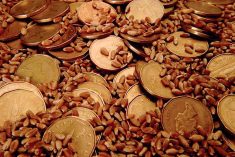Winnipeg | CNS Canada — Following two years of varying qualities for Canadian durum, the world still wants higher-quality grain, according to Rhyl Doyle.
“The world still wants (No. 1) CWAD and last year although the profile was mostly (No. 3) CWAD, they still wanted 1 CWAD. So there are a spectrum of markets for durum,” said Doyle, director of export trading with Paterson Grain, during the cereal outlook panel at Grain World in Winnipeg.
Durum crops in Canada in 2016 suffered fusarium damage, which led to lower-quality grain. Grades came in at No. 3 Canada Western Amber Durum (CWAD) and while many markets always want the higher-quality Nos. 1 and 2 grades, they were forced to take the lower-quality grain.
Read Also

U.S. grains: Soy hits four-month high on hopes for China trade deal
U.S. soybean futures jumped to their highest level in more than four months on Monday on hopes that China will resume buying American supplies after President Donald Trump said the countries were set to reach a trade deal during his trip to Asia this week.
“A lot of buyers had to improvise and so what they did was they sort of managed the specs within the 3 grade, to sort of get minimum vitreous or protein, or whatever aspect they were focused on,” Doyle said.
Countries such as Morocco will buy 600,000 to 700,000 tonnes of No. 1 CWAD usually, according to Doyle. Japan tends to prefer No. 2 or better, but is more flexible than other nations in terms of quality.
This year, however, the durum crop was good-quality, which led to markets being able to buy the higher quality again.
“We’ve seen countries like Morocco switch right back, and of course with the drought in the U.S. they’ve become very strong buyers right out of the box,” Doyle said.
But price does factor into what some markets are willing to buy, he said. For example, Italy, which is world renowned for its pasta, doesn’t usually buy No. 1 CWAD.
“They used to and they will, if the price spread is not too high. It’s a very, very competitive semolina market. The competition in that market is affecting the neighbouring countries,” Doyle said.
But prices have shifted substantially due to the change from such a low- to high-quality durum.
“Obviously the premium for 1 CWAD has really collapsed in comparison to 3s. And so we’ve seen a discount for No. 3 narrowing in very substantially close to harvest,” Doyle said.
The price spread is closing, with Doyle saying this year producers will see the price spread go from $10 to $5 per tonne for No. 1 and 2 CWAD. No. 3 CWAD will drop from $20 to a $10 spread.
— Ashley Robinson writes for Commodity News Service Canada, a Glacier FarmMedia company specializing in grain and commodity market reporting.












